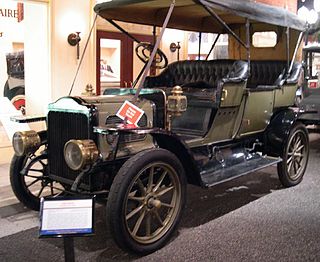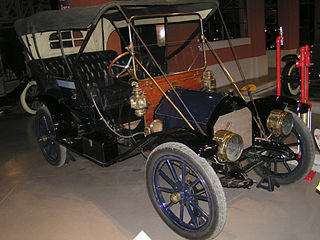Related Research Articles

The automotive industry comprises a wide range of companies and organizations involved in the design, development, manufacturing, marketing, selling, repairing, and modification of motor vehicles. It is one of the world's largest industries by revenue.

Maxwell was an American automobile manufacturer which ran from 1904 to 1925. The present-day successor to the Maxwell company was Chrysler, now Stellantis North America, which acquired the company in 1925.

The E-M-F Company was an early American automobile manufacturer that produced automobiles from 1909 to 1912. The name E-M-F was gleaned from the initials of the three company founders: Barney Everitt, William Metzger, and Walter Flanders.

A steam car is a car (automobile) propelled by a steam engine. A steam engine is an external combustion engine (ECE), whereas the gasoline and diesel engines that eventually became standard are internal combustion engines (ICE). ECEs have a lower thermal efficiency, but carbon monoxide production is more readily regulated.

Electric Vehicle Company was an American holding company that operated from 1897 to 1907 and was an early manufacturer of battery-powered automobiles.

F. B. Stearns and Company, later known as F. B. Stearns Company was an American manufacturer of luxury cars in Cleveland, Ohio marketed under the brand names Stearns from 1900 to 1911 then Stearns-Knight from 1911 until 1929.

The Owen Magnetic was a pioneering American brand of hybrid electric luxury automobile manufactured between 1915 and 1922. Car models of the brand were notable for their use of an electromagnetic transmission and were early examples of an electric series hybrid drivetrain. The manufacture of the car was sponsored by R.M. Owen & Company of New York, New York. The car was built in New York City in 1915, in Cleveland, Ohio, between 1916 and 1919 and finally in Wilkes-Barre, Pennsylvania, in 1920 and 1921.

A high wheeler is a car which uses large diameter wheels that are similar to those used by horse-drawn vehicles. These cars were produced until about 1915, predominantly in the United States.

Moon Motor Car Company was an American automobile company that was located in St. Louis, Missouri. The company had a venerable reputation among the buying public, as it was known for fully assembled, easily affordable mid-level cars using high-quality parts. Often this meant the manufacturing process required more human intervention, leading to operating losses. The company was founded by carriage maker Joseph W. Moon. Moon produced both cars and trucks.

The Everitt was an American automobile manufactured from 1909 until 1912 by the Metzger Motor Car Company in Detroit, Michigan.

The Fal-Car, originally known as A Car Without A Name, was an American automobile manufactured from 1909 until 1914 by a company that identified itself in advertisements only as Department C, 19 North May Street, Chicago. The address had previously been the location where the Reliable-Dayton automobile had been built. It was advertised as "trim, classy, speedy and efficient".
The De Luxe was an American automobile manufactured in 1907 by the De Luxe Motor Car Company of Detroit, Michigan. The De Luxe was a high-priced vehicle for its day, retailing for around $5000. De Luxe took over the factory belonging to the Kirk Manufacturing Company, maker of the Yale automobile in Toledo, Ohio, in 1906. Soon after, De Luxe moved to a brand new facility on a 15-acre (61,000 m2) site on Clark Street at Jefferson Avenue in Detroit. After producing fewer than 100 cars in 1908, the company was acquired by the E-M-F Company in 1909. The factory was used by E-M-F to build the Flanders 20. E-M-F was acquired by Studebaker in 1910, who continued to produce automobiles in Detroit until its operations were moved to South Bend, Indiana, in the 1920s.

The Hol-Tan was an American automobile manufactured in 1908 only.

The Cutting was an American automobile manufactured in Jackson, Michigan by the Clark-Carter Automobile Company from 1909 to 1912, and the Cutting Motor Car Company in 1913. It was made in the same factory as previously produced the C.V.I. make. The Cutting was engineered by Charles Cutting, using engines from Milwaukee, Model, and Wisconsin ranging from 30 to 60 hp. Prices ranged from $1,200 to $1,500. In 1912 the company claimed to have the highest power-to-price ratio of any car at or above the $1,200 price.
Detroit Auto Vehicle Company was a short-lived early automobile manufacturer established in the summer of 1904 with a capital stock of US$150,000. Based in Detroit in the old Detroit Novelty Machine Company building, it also had a foundry in Romeo, Michigan. It ceased operation in October 1907 following bankruptcy.

The Selden Motor Vehicle Company was a Brass Era American manufacturer of automobiles. The company, founded in 1906, was based in Rochester, New York, and built automobiles from 1907 to 1914 and trucks from 1913 to 1932.
The automotive industry in Massachusetts refers to a period of time from 1893 to 1989 when automobiles were manufactured in the Commonwealth of Massachusetts commercially. In the early years, the state produced more automobiles than Detroit, Michigan. During the 20th century, General Motors and the Ford Motor Company were producing automobiles at the Framingham Assembly and Cambridge Assembly, respectively.
Beverly Rae Kimes was an American automotive journalist and historian, known as the "First Lady of Automotive History" and "The Grande Dame of Automobile History". She was born in West Chicago, Illinois on August 17, 1939 and grew up in Wheaton, Illinois. She received a bachelor's degree from the University of Illinois, and a master's degree in journalism from the Pennsylvania State University.

Arnold Clark is a car dealer based in Glasgow, Scotland. As of 2022, the company has 193 dealerships across the United Kingdom.
References
- ↑ Henry A. Clark (1985). Beverly R. Kimes (ed.). The Standard Catalog of American Cars 1805–1945. Krause Publications. ISBN 0-87341-045-9.[ page needed ]
- Georgano, G.N. (1968). The Complete Encyclopedia of Motorcars, 1885 to Present.[ page needed ]